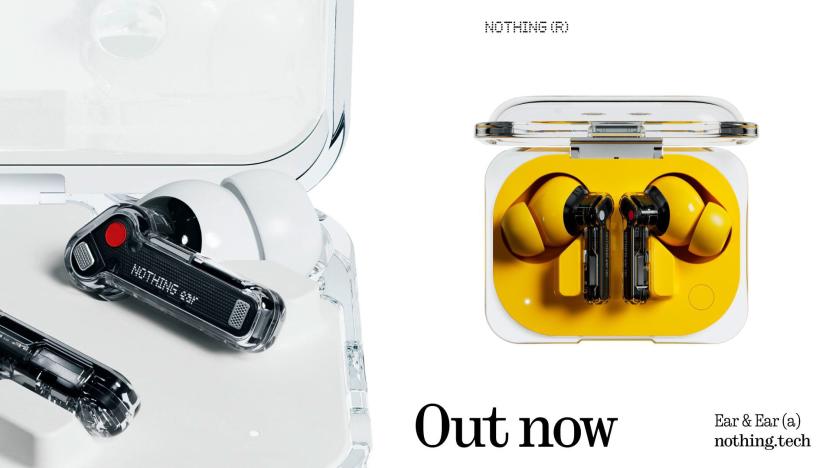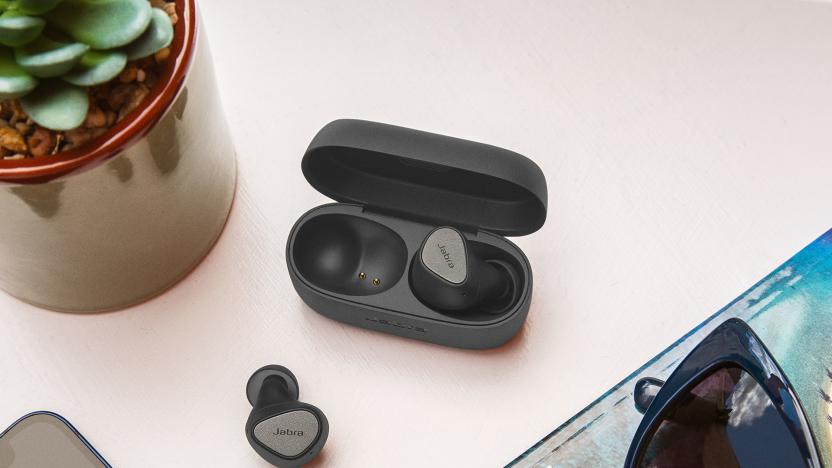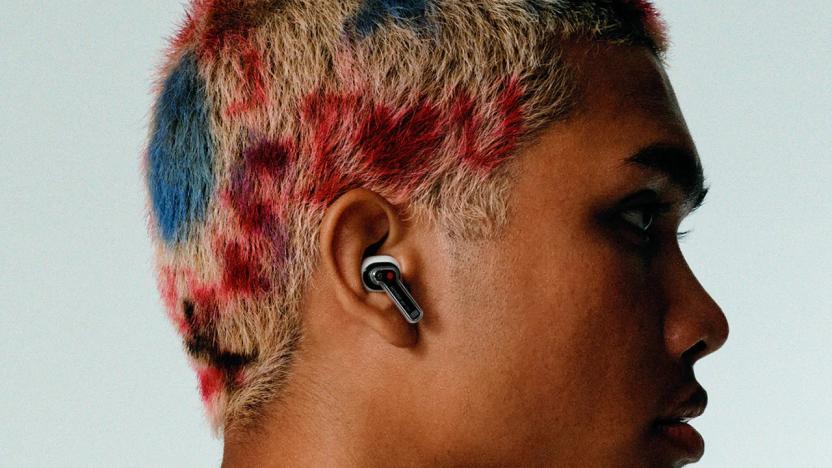Ear
Latest

Nothing's Ear and Ear (a) earbuds with active noise cancellation are now available for pre-order
Nothing has introduced the Ear and the Ear (a) earbuds at an event in Tokyo.

Jabra's Elite 4 earbuds forgo a few niceties for a $20 price cut
Jabra has unveiled regular Elite 4 earbuds that offer most of the Active's features at a lower price.

Nothing raises the price of its Ear 1 buds to $149 citing increased costs
Nothing's Ear 1 wireless earbuds will cost $149 starting on October 26th.

Next-gen hearing implants could overcome inner ear damage
Many hearing implants won't help people with inner ear damage or auditory nerve problems, but the brainstem implants that do frequently do an incomplete job. Soon, however, there might be a far better solution. Researchers have designed a conformable electrode implant that should more effectively counter inner ear damage. It uses body-safe, resilient platinum for electrodes, but overcomes the metal's usual stiffness thanks to micron-level machining inspired by kirigami paper cutting. Once wrapped in silicone, it's highly conductive but can cling tightly to the auditory brainstem and send more targeted signals than in conventional implants.

Researchers treat ear defect by growing implants from cells
While scientists have been working on growing organs and body parts like ears for some time, researchers in China have taken it one important step further. They've grown new ears for five children with microtia -- an ear defect that results in small, underdeveloped ears and often affects hearing -- grafted them onto the children and continued to observe the development for over two years. The work is important because it's the first study of its kind and shows that these sorts of methods stand to be a viable option going forward.

NEC can verify your identity using sound-capturing earbuds
Sure, you could use your fingerprint to unlock your phone, but NEC developed a way to verify your identity with your ears. The corporation announced technology this week that used the way in which sound resonates in the ear canal to identify a person. Ear shape is also unique to each of us, so NEC created a way for microphone-equipped earbuds to measure the acoustics after sending out a sound. What's more, the company says the technology works with 99 percent accuracy and only takes about a second to take its measurements.

Princeton crafts a 3D printed bionic ear with super hearing, creepy looks
Scientists have toyed with printing ear implants for ages, but they've usually been more cosmetic than functional. Princeton has just developed a bionic ear that could transcend those mere replacements to offer a full-on upgrade. Rather than seed hydrogel with cells and call it a day, the researchers 3D printed a blend of calf cells, hydrogel and an integrated, coiled antenna made from silver nanoparticles. The frankly spooky project doesn't resemble a natural ear all that closely, but it merges organic and synthetic more gracefully than inserting a chip into an existing implant. It can also expand hearing beyond normal human levels: the experimental version picks up radio waves, for example. Although the ear is just the first step on a long path toward natural-feeling bionics, it already has us wondering if we'll be actively seeking out replacement body parts in the future... not that we're about to go all Van Gogh to get them.

Cornell scientists 3D print ears with help from rat tails and cow ears
Science! A team of bioengineers and physicians over at Cornell University recently detailed their work to 3D print lifelike ears that may be used to treat birth defects like microtia and assist those who have lost or damaged an ear due to an accident or cancer. The product, which is, "practically identical to the human ear," according to the school, was created using 3D printing and gels made from living cells -- collagen was gathered from rat tails and cartilage cells were taken from cow's ears. The whole process is quite quick, according to associate professor Lawrence Bonassar, who co-authored the report on the matter, "It takes half a day to design the mold, a day or so to print it, 30 minutes to inject the gel, and we can remove the ear 15 minutes later. We trim the ear and then let it culture for several days in nourishing cell culture media before it is implanted." The team is looking to implant the first ear in around three years, if all goes well.

MIT ear-powered wireless sensor sustains its charge through sound
You wouldn't immediately think of the ear's cochlea as an energy source, but MIT knows that every mammal effectively has a pair of very small power plants because of the ionized environment. School researchers are trying to harness that energy through a new sensor that exploits the whole ear canal system. As eardrum vibrations naturally create a usable voltage from brain signals, the prototype can build enough charge in a capacitor to drive a very low-power wireless transmitter that relays the electrochemical properties of the ear and potentially diagnoses balance or hearing problems. The beauty of the system is its true self-sustainability: once the transmitter has been been jumpstarted with radio waves, it powers itself through the resulting transmissions. Energy use is also sufficiently miserly that the sensor doesn't interrupt hearing. Work is still early enough that there's a long way to go before such implants are part of any treatments, but there's hope that future chip iterations could help fix inner ear maladies, not just report on them. Something tells us, however, that the doctor won't ask us to take two dubstep tracks and call back in the morning.

Trouble hearing? Advanced Bionics' waterproof implant is paddling your way
If you're one of the 200,000 deaf people who've received cochlear implants, then here's an upgrade worth considering: the Neptune from Advanced Bionics claims to be "the world's first and only swimmable, waterproof sound processor," and it's just received certification for the US and Canada. Read on for more details in the full press release and soon you could be bantering while you bathe.

Asius' ADEL earbud balloon promises to take some pressure off your poor eardrums
Listener fatigue: it's a condition that affects just about everyone who owns a pair of earbuds and one that myriad manufacturers have tried to mitigate with various configurations. According to researchers at Asius Technologies, though, the discomfort you experience after extended periods of earphone listening isn't caused by faulty design or excessively high volumes, but by "acoustic reflex." Every time you blast music through earbuds, your ear muscles strain to reduce sound waves by about 50 decibels, encouraging many audiophiles to crank up the volume to even higher, eardrum-rattling levels. To counteract this, Asius has developed something known as the Ambrose Diaphonic Ear Lens (ADEL) -- an inflatable polymer balloon that attaches to the ends of earbuds. According to Asius' Samuel Gido, the inflated ADEL effectively acts as a "second eardrum," absorbing sound and redirecting it away from the ear's most sensitive regions. No word yet on when ADEL may be available for commercial use, but head past the break for a video explanation of the technology, along with the full presser.

PlayStation 3's Bluetooth headset slims down, shines on, adorns ears later this month
My, what a difference a couple years makes. As we suspected, Sony is updating its old Bluetooth headset design with a decidedly more elegant model. Here's what we've got: dual mics, USB pairing, in-game status indicator, a charge cradle that doubles as a desktop mic, and of course, a giant mute button for when you have only moments to smack yourself in the ear and curse loudly about your good-for-nothing teammates. It's also smaller and glossier -- and rocking the same $49.99 price tag. When's it arriving? Soon, later this month. When is that, exactly? Have patience.

Biometric ear scanning developed as a comical alternative to iris, fingerprint scans
The field of biometrics is a never-ending spectacle of palm readers, fingerprint and iris scanners, and now researchers at the University of Southampton may have discovered the next body part to be cataloged and tracked by power-mad governments: the ear. According to Professor Mark Nixon, the human ear is made up of "a whole load of structures" that can generate measurements that are unique to an individual. "With facial recognition," he says "the systems are often confused by crows feet and other signs of aging. Your ears, however, age very gracefully. They grow proportionally larger and your lobe gets a bit more elongated, but otherwise your ears are fully formed from birth." And unlike iris scanning, which is a cumbersome process, the ear scanning is relatively quick and painless. Unless, of course, you're dealing with long-haired hippie radicals. If they rise up again, no amount of ear scanning will keep us safe.

VNS implant might fix the ringing in your ears
Earlier this decade, doctors discovered that by shocking the vagus nerve -- one of twelve nerves connected directly to the brain -- they could attempt to treat chronic hiccups, epilepsy and severe depression. Now, a startup called Microtransponder believes such a device can help reduce tinnitus, too. Technology Review now reports the company's RFID-like, externally-powered implant could stimulate the vagus nerve while doctors play particular tones for those suffering ringing ears, slowly attuning the patients to frequencies other than the one that ails them. As with all new medical procedures, we don't expect to see this one on the market anytime soon, but the firm does claim it's just raised $10 million in funding and will pursue FDA clearance accordingly. Until then, you'll just have to try less invasive procedures, or simply restrain yourself from turning that volume dial to 11. Ch'yeah right!

MIT scientists reverse engineer the ear for ultra-broadband, low power RF chip
Researchers at MIT have developed an ultra-broadband radio chip that's faster than any existing RF spectrum analyzer, while consuming 100 times less power. The RF Cochlea mimics the neural signal processing of the human cochlea, which uses fluid mechanics, piezoelectrics and neural signal processing to convert sound waves into electrical signals which travel to the brain. "The more I started to look at the ear," said Rahul Sarpeshkar, associate professor of electrical engineering and computer science, "the more I realized it's like a super radio with 3,500 parallel channels." The team has recently filed for a patent to incorporate the chip in a universal or software radio architecture that will process a broad spectrum of signals including cellular phone, wireless Internet, FM, and other signals. Ultimately, this tech could be used to build a universal radio that could receive a broad range of frequencies. Meet Professor Sarpeshkar in the video after the break.[Via Daily Tech]

Neuromonics Oasis quiets the ring in your ears, won't stop the voices
Do you have a constant, annoying ringing in your ears? If you're like us, you probably suffer from at least a mild form of tinnitus. Whether it's from exposure to massive jet engines, or just listening to Reign in Blood one too many times, you probably wish there was some way to stop the incessant noise. Well, a company called Neuromonics may be able to help, using an audio player which alternates a mixture of white noise and music to train your brain to ignore the ringing. The player gradually reduces the level of the white noise, and after six months of treatment, patients can use the device as needed. This kind of relief doesn't come for free, however, as counseling and the unit will cost you $3,000 to $6,000, and you probably won't be able to get your insurance to pay for it.[Via Medgadget]

Performance artist Stelarc implants "third ear" in forearm
Picking up where the Vacanti mouse left off, Australian performance artist Stelarc went through with his plans to implant a cell-cultivated ear beneath the skin of his forearm earlier this year, and he's now showing off the results for the world to squirm at. Stelarc apparently isn't satisfied with his newfound appendage just yet, however, and is reportedly planning another surgery to give the ear "more definition." What's more, he's also hoping to implant a microphone inside the ear that'll use a Bluetooth transmitter to, you guessed it, broadcast what it hears over the Internet.[Via Boing Boing, photo courtesy of Nina Sellars]







